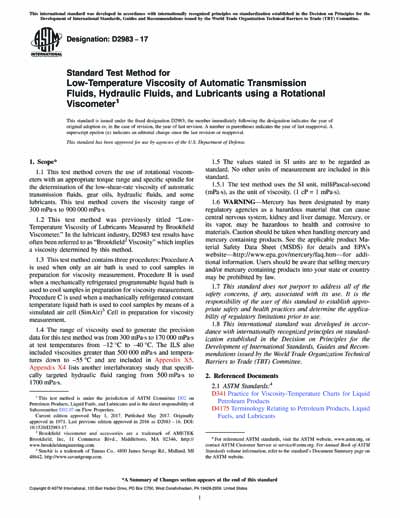Historical
ASTM D2983-17
Standard Test Method for Low-Temperature Viscosity of Automatic Transmission Fluids, Hydraulic Fluids, and Lubricants using a Rotational Viscometer
1.1 This test method covers the use of rotational viscometers with an appropriate torque range and specific spindle for the determination of the low-shear-rate viscosity of automatic transmission fluids, gear oils, hydraulic fluids, and some lubricants. This test method covers the viscosity range of 300 mPa·s to 900 000 mPa·s
1.2 This test method was previously titled “Low-Temperature Viscosity of Lubricants Measured by Brookfield Viscometer.” In the lubricant industry, D2983 test results have often been referred to as “Brookfield2 Viscosity” which implies a viscosity determined by this method.
1.3 This test method contains three procedures: Procedure A is used when only an air bath is used to cool samples in preparation for viscosity measurement. Procedure B is used when a mechanically refrigerated programmable liquid bath is used to cool samples in preparation for viscosity measurement. Procedure C is used when a mechanically refrigerated constant temperature liquid bath is used to cool samples by means of a simulated air cell (SimAir)3 Cell in preparation for viscosity measurement.
1.4 The range of viscosity used to generate the precision data for this test method was from 300 mPa·s to 170 000 mPa·s at test temperatures from –12 °C to –40 °C. The ILS also included viscosities greater than 500 000 mPa·s and temperatures down to –55 °C and are included in Appendix X5. Appendix X4 lists another interlaboratory study that specifically targeted hydraulic fluid ranging from 500 mPa·s to 1700 mPa·s.
1.5 The values stated in SI units are to be regarded as standard. No other units of measurement are included in this standard.
ASTM International [astm]

